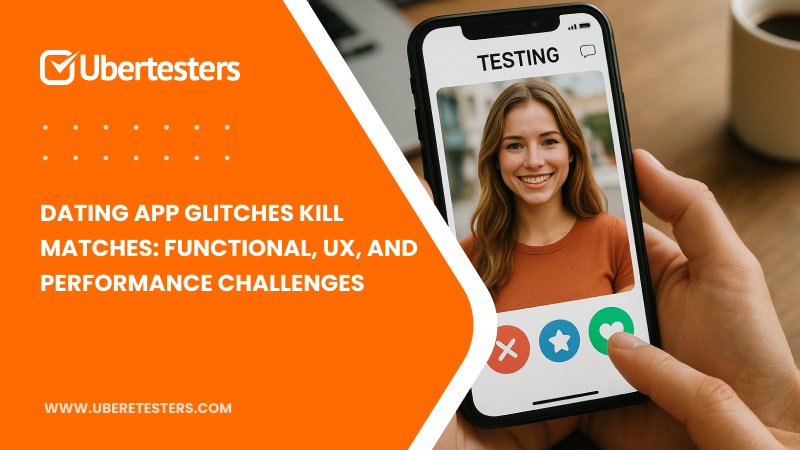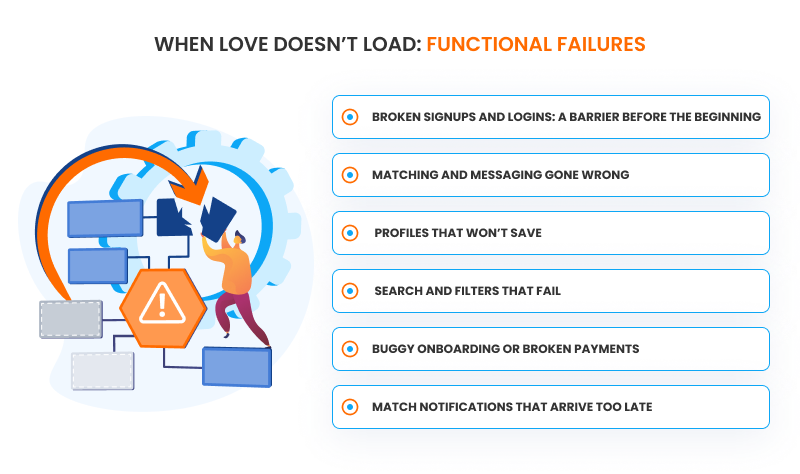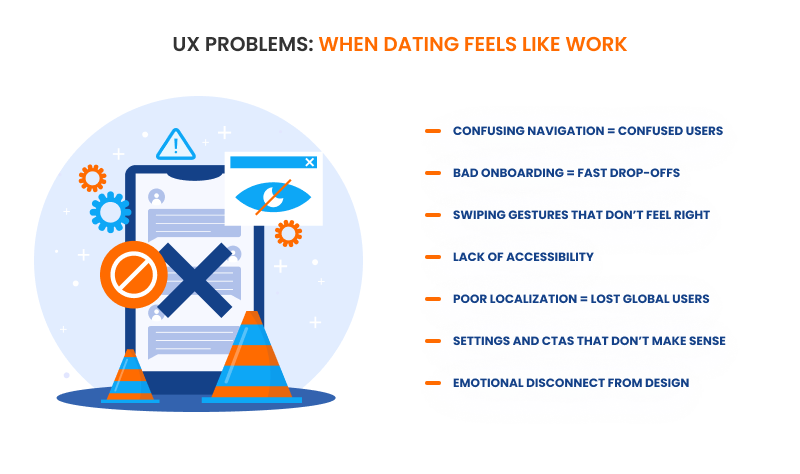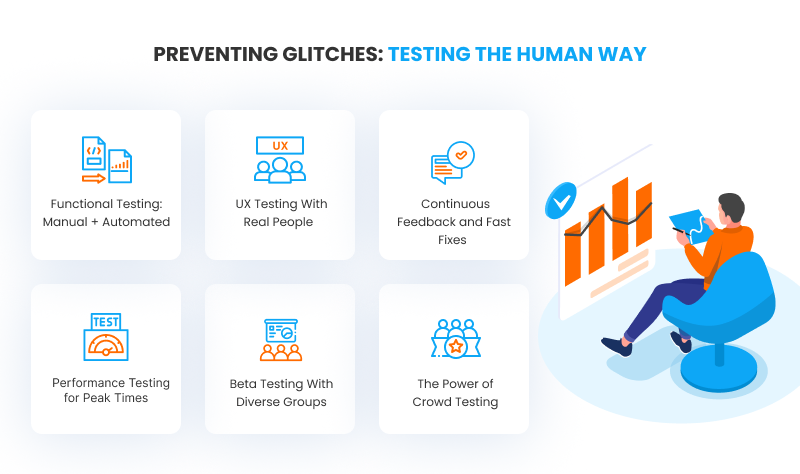Dating App Glitches Kill Matches: Functional, UX, and Performance Challenges

You’ve just matched with someone who seems like your perfect type. You open the app, heart racing, ready to send that first clever message… but the app freezes. You reload. Still nothing. Maybe they unmatched? Or maybe the application just glitched again.
Welcome to the frustrating world of dating app glitches, where technical failures don’t just ruin software—they ruin potential relationships. Dating apps promise us love, connection, and companionship. They’ve become one of the primary ways people meet today, especially in a world where digital-first interactions are the norm. That means when your app breaks, it’s not just inconvenient—it’s emotional.
And it all boils down to three critical areas of the app and what should be carefully tested: functionality, user experience, and performance. Let’s dive into the many ways these technical aspects impact your users—and how to fix them before your product drives love-seekers away for good.
When Love Doesn’t Load: Functional Failures

Even the most beautifully designed dating app is useless if it doesn’t work. Functional bugs are the silent killers of user trust.
Broken Signups and Logins: A Barrier Before the Beginning
If a new user can’t even sign up or log in, you’ve lost them before they even start. Common issues include:
- Social login integrations (Google, Facebook) are failing
- Verification codes are not sending or timing out
- Infinite loading loops or error screens on login
This is the first moment of truth—and if it fails, the application is dead on arrival.
Matching and Messaging Gone Wrong
Core interactions like swiping and messaging must be bulletproof. Users report:
- Swipes not registering
- Matches disappearing
- Messages are not sending or showing up out of order
These aren’t just technical bugs—they break the entire purpose of the app.
Profiles That Won’t Save
You finally write a great bio, upload flattering photos, hit save—and nothing changes. This is a major trust-breaker. People invest time in building a digital version of themselves. If the app can’t save it, they’ll leave.
Search and Filters That Fail
Dating platforms’ filters are powerful tools to help users narrow down potential matches. But bugs in the system can:
- Return irrelevant profiles
- Ignore set preferences
- Show the same profiles over and over
This leads directly to user frustration with dating apps, especially when users pay for advanced filter features.
Buggy Onboarding or Broken Payments
Onboarding should be smooth and intuitive. But glitches like failed walkthroughs, missing tooltips, or error-ridden payment flows cause drop-offs. If users can’t pay for a boost or premium feature because of a bug, you’re also losing revenue.
Match Notifications That Arrive Too Late
Imagine receiving a match notification three hours after it happened. That initial excitement is lost. Push notifications that don’t work—or are delayed—kill real-time interaction.
These issues can be uncovered earlier and more reliably when your testing strategy includes external testers who aren’t familiar with your product, bringing a completely unbiased, fresh perspective that internal teams often miss.
These issues can be found in advance with solid dating app functional testing, which should be a priority from early development through every release.
UX Problems: When Dating Feels Like Work

An app doesn’t have to be broken to drive users away. Sometimes, it’s just frustrating to use. These are classic UX challenges in dating apps, and they often go unnoticed by developers who are too close to the product.
Confusing Navigation = Confused Users
Navigation should be simple. But many apps bury key actions under too many taps or use icons that are hard to understand. If users can’t find what they need, they won’t stay long.
Bad Onboarding = Fast Drop-offs
First impressions matter. Unintuitive onboarding flows, missing guidance, or too many early requests for personal info can overwhelm new users.
This is why good mobile dating app testing and real-world UX testing, especially with a diverse crowd of testers managed by a professional QA lead, can expose friction points your team may never have considered.
Swiping Gestures That Don’t Feel Right
Every dating application has its own gesture logic. But inconsistent or glitchy swiping behavior—like accidental left swipes or lag—can lead to missed matches and angry users.
Lack of Accessibility
Most apps fail to accommodate users with visual, hearing, or motor impairments. Accessibility is not optional—it’s part of providing a good dating app user experience for all users.
Poor Localization = Lost Global Users
If your software is live in multiple countries, localization matters. That includes:
- Accurate translations
- Local currency formats
- Cultural sensitivity in profile prompts
Localization testing is a must in any strong dating app QA process.
Settings and CTAs That Don’t Make Sense
Overloaded settings menus, confusing toggle behaviors, and unclear call-to-action buttons (“Continue” vs. “Save”) leave users guessing.
Emotional Disconnect from Design
A sleek design isn’t enough. People want warmth, empathy, and clarity in design. If the app feels cold, robotic, or too transactional, it won’t support emotional connection—which is the entire point.
Use UX testing with real users to understand what they feel, not just what they tap.
Performance Pitfalls: When the App Slows Down Love

Even when features work and the interface looks nice, performance issues can quietly drive users away.
Weekend Crashes = Peak Time Failures
Dating apps experience traffic surges in the evenings and on weekends. Without proper performance testing for dating apps, these peaks can cause:
- Server crashes
- Session timeouts
- Profile loading errors
This is when people use your app the most. Downtime here is disastrous.
Lag in Profile and Message Loading
Nobody wants to wait ten seconds for a profile to load. Slow loading times make the program feel broken and kill spontaneous interaction.
Slow Image Loads = Poor First Impressions
If someone’s photo takes too long to load, users swipe left out of impatience—or miss the chance to connect entirely.
Battery Drain and Data Hogging
Some apps burn through batteries or consume too much data. This leads users to delete the program without a second thought.
App Freezing and Crashes
Freezes during swiping or chatting are especially damaging. They interrupt flow, create confusion, and make the platform feel unstable.
Low-Network Performance
Many users date while commuting, traveling, or in places with weak connections. If your app doesn’t handle low bandwidth gracefully, it creates user frustration with dating apps—especially in emerging markets.
The advantage of field testers in your target markets is they test on real devices, real networks, and real-world conditions, surfacing problems you won’t find in a controlled lab environment.
These issues demand serious dating app performance optimization and robust testing across device types and network conditions.
Real-World Costs of Technical Failures
Dating app bugs don’t just annoy users—they have business consequences.
- Missed connections = missed revenue. Every failed match or message is a lost opportunity for user engagement and monetization.
- Negative reviews go viral. Angry users leave 1-star reviews, post on social media, and drive new users away.
- User retention drops. Even one bad experience can lead users to uninstall and never come back.
- Revenue shrinks. Bugs in subscriptions, boosts, or payment processing directly impact profits.
- Brand trust erodes. Once users feel the service can’t deliver emotionally meaningful experiences, they move on.
These are common reasons why dating apps fail, even with strong marketing and early traction.
Preventing Glitches: Testing the Human Way

How can dating apps avoid these pitfalls? It starts with a smart, thorough dating app QA (Quality Assurance) and testing process.
1. Functional Testing: Manual + Automated
Both manual testing for dating apps and automation are key. Manual testing finds nuanced bugs, while automation ensures consistent regression checks.
Use a clear dating app testing checklist to cover:
- Signup/login
- Swiping/matching
- Messaging
- Profile editing
- Filters/search
- Payments
2. UX Testing With Real People
Automated tools can’t tell you how users feel. Real end-to-end dating app testing with actual people from your target market, with real devices, reveals friction points, confusing flows, and missed emotional opportunities.
3. Performance Testing for Peak Times
Performance testing for dating apps should simulate real-world loads, especially during peak usage times like Friday night. Test for:
- Server response times
- Load balancing
- App responsiveness under pressure
4. Beta Testing With Diverse Groups
Release early builds to diverse beta testers across device types, languages, and regions. This helps catch dating app performance issues before launch.
Even better, run these cycles through a coordinated crowd-testing platform where test management is centralized, testers are vetted, and you work with an experienced project manager who translates test results into actionable improvements.
5. Continuous Feedback and Fast Fixes
Allow in-app feedback reporting. Combine it with analytics and session recording to understand user pain points. Build rapid fix-and-deploy cycles into your dev process.
6. The Power of Crowd Testing
Embrace the power of real-world testing with a diverse global community. This is where crowd testing shines. Using human testers from different regions, networks, and devices gives unmatched insights. They spot the kind of UX challenges in dating apps, lag spikes, and weird bugs that automation misses entirely. It’s not just quality control—it’s building trust at scale.
Some providers even offer hybrid models, giving you access to a consistent group of professional testers who stay with your project over time, essentially becoming your external QA team. This brings the stability of an in-house team, without the overhead.
To Wrap Up
A dating app isn’t just code—it’s a bridge to real human relationships. And every glitch, freeze, or confusing button threatens that emotional connection. To build apps that help people connect, fall in love, or simply meet someone new, you need to prioritize dating application testing, across functionality, UX, and performance, including real-world human testing (like crowd testing), to ensure what you're building actually works for the people you're building it for.
Whether it’s through robust functional testing, real-user UX testing, or peak-load performance testing, your QA approach should reflect the emotional importance of your product. In this space, testing is not optional—it’s care. It’s trust. And it’s the foundation of long-term growth. Because when your app works perfectly, love might just follow.
Start building a smoother dating experience—connect with our team today.

